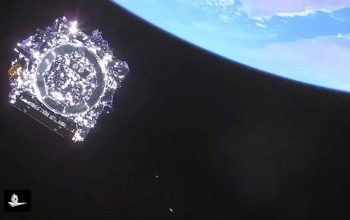Sunday, August 14th
Jupiter shines at a magnitude -1.7 within the western portion of the Virgo constellation a half hour after sunset. Since it is low in the sky- around 10 degrees high- the planet’s detail is limited when seen through a telescope. During the predawn hours, M31, the Andromeda Galaxy, can be viewed through binoculars under clear skies. We can start to see objects-such as Andromeda- typical of the autumn sky in the predawn hours. The galaxy is located northwest from Pegasus and directly south from Cassiopeia. The moon illuminates 83% as a Waxing Gibbous, with moonrise at 5:06 p.m. and moonset at 3:13 a.m.
Monday, August 15th
Although only half as high as Jupiter, Venus will shine brighter at a magnitude -3.8. An unobstructed horizon is needed to view the planet in the western sky during evening twilight hours. Mercury is faintly visible at the lower right of Jupiter. The moon illuminates 90% as a Waxing Gibbous, with moonrise at 5:55 p.m. and moonset at 4:11 a.m.
Tuesday, August 16th
The triangle formed between Jupiter, Mercury, and Venus becomes smaller in the coming weeks. Today Mercury reaches its greatest elongation, but still appears low in the sky for viewers in the mid- northern latitudes. Look 5˚ high around 30 minutes after sunset to view the small, inner planet. Bright Betelgeuse shines in the eastern sky. The moon is nearly full, with an illumination reaching 96% as a Waxing Gibbous. The moonrise is at 6:40 p.m. and moonset at 5:13 a.m.
Wednesday, August 17th
The sky will be illuminated by a Full Moon, with moonrise at 7:22 p.m. and moonset at 6:19 a.m. the next day.
Thursday, August 18th
The Great Square of Pegasus begins to rise in the east after sunset. The stars Alpheratz, Scheat, Markab, and Algenib comprise the four corners of the Great Square. In the southwest sky, Saturn still shines at around 9 p.m. and forms a vertex of a triangle, along with Mars and Antares. The Full Moon continues to shine, reaching its peak at 5:27 a.m. Moonrise is at 8:02 p.m. and moonset at 7:27 a.m.
Friday, August 19th
Neptune shines at a dim magnitude 7.8 located in Aquarius. We are dawning upon its opposition, occurring 2 weeks from today. Neptune rise at 8:30 p.m. and can be best seen at 2:30 a.m. in the south. The moon illuminates at 98% as a Waning Gibbous, with moonrise at 8:39 p.m. and moonset at 8:36 a.m.
Saturday, August 20th
The sky is transiting from summer to autumn constellations. Cassiopeia extends across the northeast and the Big Dipper appears lower in the northwest. The moon illuminates at 94% as a Waning Gibbous, with moonrise at 9:15 p.m. and moonset at 9:46 a.m.
*NOTE: Moonrise and moonset times based on EDT. Click here to calculator your local times.
Published by Julia Mariani
Sources: Sky and Telescope, Astronomy Magazine, StarDate of McDonald Observatory, timeanddate.com, Moongiant.


